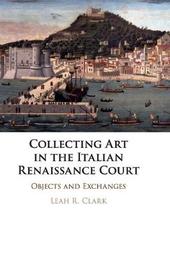
|
Collecting Art in the Italian Renaissance Court: Objects and Exchanges
Hardback
Main Details
| Title |
Collecting Art in the Italian Renaissance Court: Objects and Exchanges
|
| Authors and Contributors |
By (author) Leah R. Clark
|
| Physical Properties |
| Format:Hardback | | Pages:338 | | Dimensions(mm): Height 261,Width 183 |
|
| Category/Genre | Art History
Renaissance art
History |
|---|
| ISBN/Barcode |
9781108427722
|
| Classifications | Dewey:709.4509024 |
|---|
| Audience | | Professional & Vocational | |
|---|
| Illustrations |
Worked examples or Exercises; 8 Plates, color; 57 Halftones, black and white
|
|
Publishing Details |
| Publisher |
Cambridge University Press
|
| Imprint |
Cambridge University Press
|
| Publication Date |
28 June 2018 |
| Publication Country |
United Kingdom
|
Description
In this book, Leah R. Clark examines collecting practices across the Italian Renaissance court, exploring the circulation, exchange, collection, and display of objects. Rather than focusing on patronage strategies or the political power of individual collectors, she uses the objects themselves to elucidate the dynamic relationships formed through their exchange. Her study brings forward the mechanisms that structured relations within the court, and most importantly, also with individuals, representations, and spaces outside the court. The volume examines the courts of Italy through the wide variety of objects - statues, paintings, jewellery, furniture, and heraldry - that were valued for their subject matter, material forms, histories, and social functions. As Clark shows, the late fifteenth-century Italian court an be located not only in the body of the prince, but also in the objects that constituted symbolic practices, initiated political dialogues, caused rifts, created memories, and formed associations.
Author Biography
Leah R. Clark is a Lecturer in the Department of Art History at The Open University, Milton Keynes. Her research explores the roles that the exchange, collection, and replication of objects played in the creation of social networks in the fifteenth century. She is co-editor (with Nancy Um) of a special issue of the Journal of Early Modern History, and her work has appeared in a number of publications including the Journal of the History of Collections. She has received prestigious awards and fellowships from a variety of institutions including the Social Sciences and Humanities Research Council of Canada, the British Academy and the Arts and Humanities Research Council.
Reviews'Clark shows that diplomatic, economic and dynastic links between fifteenth-century Italian Renaissance elites were sustained by the circulation of art objects: not just traditional paintings and sculptures, but objects of symbolic and material value as heraldic collars, jewels, furniture, and textiles. In their circulation as gifts between influence-brokers and powerful individuals, these prestige commodities acquire social and cultural biographies and sustain layers of complex interpretation that have a crucial bearing on the selfhood and agency of their owners. Clark's indispensable new study is especially to be welcomed for its attention to the court of Naples, neglected in anglophone scholarship, and here shown to be crucial to the statecraft of Ferrara and Florence. ' Stephen Campbell, The Johns Hopkins University 'In this illuminating book, Leah R. Clark shows that objects in princely collections did much more than reflect the magnificence of the ruler. Works of art in whatever media - including books, textiles, medals and gems as well as paintings and sculpture - interacted with each other in complex webs of intertextuality. As the fascinating case-studies indicate, the meaning of objects was inherently unstable. When given away, borrowed, bought, or pawned, they acquired shifting cultural dimensions. Their value was continually renegotiated through diplomacy, social display, or private study and contemplation, while their significance depended just as much on their dialogues with each other, and with their owners, as on their individual appearance, subject matter, materials and workmanship. This perceptive reinterpretation casts new light on the dynamics of court culture in the Italian Renaissance.' Deborah Howard, Professor Emerita of Architectural History, University of Cambridge 'Collecting Art in the Italian Renaissance Court: Objects and Exchange offers both scholars and students of art history an invaluable insight into the complex web of connections facilitated by a range of objects in Early Modern Italy - it is essential reading for anyone interested in the narratives built around art objects.' Marika Leino, Oxford Brookes University 'Clark's book is manifestly successful when it lets her strategically chosen case studies shine in their particularity. Her fine-grained research is new, and it demonstrates how objects could operate in different roles in Quattrocento Italy.' Gail Feigenbaum, Renaissance Quarterly 'Taking objects - as opposed to people - as her protagonists, Leah Clark proposes an innovative approach to the history of collecting art in fifteenth-century Italian courts ... the scope of Clark's book reaches well beyond collecting.' Gail Feigenbaum, Renaissance Quarterly
|